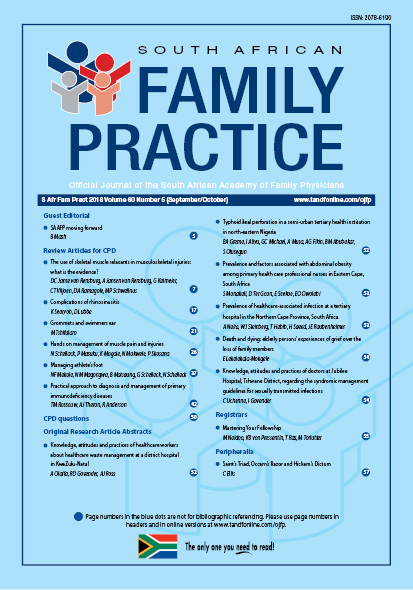Prevalence and factors associated with abdominal obesity among primary health care professional nurses in Eastern Cape, South Africa
Abstract
Background: Nurses are key stakeholders in health promotion and obesity management, yet a high-risk group for obesity development. This study examined the prevalence and correlates of abdominal obesity among primary health care professional nurses (PHCPNs) in Eastern Cape, South Africa.
Methods: This cross-sectional study involved 203 PHCPNs conveniently selected across 41 primary health care facilities in Eastern Cape, South Africa. The WHO STEPwise questionnaire was used for data collection. Abdominal obesity was defined according to the WHO criteria as a waist circumference ≥ 94 cm for men and ≥ 80 cm for women or waist-to-hip ratio ≥ 0.90 in men and ≥ 0.85 in women; and a waist-to-height ratio of > 0.50.
Results: The prevalence of abdominal obesity ranged from 50%, to 87% to 90%, using waist-to-hip ratio, waist circumference and waist-to-height ratio, respectively. Age, gender and duration of practice were significantly associated with abdominal obesity. After adjusting for potential confounders, only age > 30 years (OR = 6.7; 95% CI = 2.4–18.7; p < 0.001) and female sex (AOR = 7.9; 95% CI = 2.4–18.7; p < 0.001) were independent predictors of obesity.
Conclusion: There is a high prevalence of abdominal obesity among PHCPNs in Eastern Cape, South Africa, which was associated with female sex and ageing. This constitutes a potential risk for the healthcare workforce of the province and might be an impediment to adequate conveyance to patients of health education on healthy weight management by the affected nurses. There is an urgent need for appropriate workplace health policies targeted towards the promotion of physical activities, healthy lifestyle and ultimately weight reduction among this group.
Full text of the research articles are available online at S Afr Fam Pract 2018; DOI: 10.1080/20786190.2018.1467181

